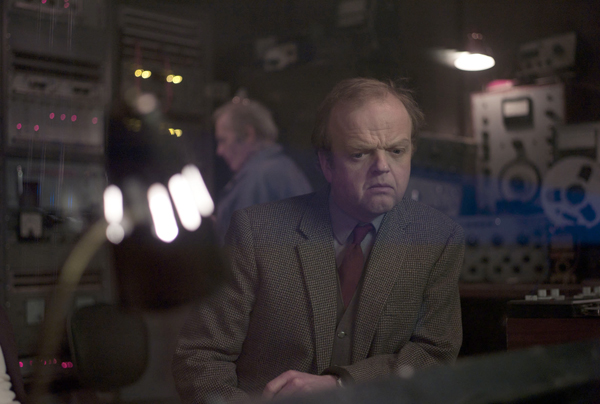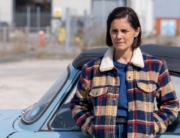Peter Strickland’s second feature is an inventive homage to the art of analogue sound and the power of the medium. Sometime in the 1970s, sound engineer Gilderoy (Toby Jones), a meek, middle-aged English bachelor, and a specialist in nature documentaries, accepts a job to engineer the soundtrack for an Italian film. The job transplants him from the sedate rural life he shares with his mother to a cheap sound studio in Rome. He has no idea what elusive director Santini (Antonio Mancino) has in the can beyond the title, “The Equestrian Vortex,” and he’s confronted by twin Foley goons in lab coats smashing watermelons to bits.
Trapped in the studio with a manipulative producer, Francesco (Cosimo Fusco), and a monosyllabic, aged, studio manager, Gilderoy recoils at the violent, exploitative horror movie that Francesco is making. Ignorant of the language and culture, Gilderoy is overwhelmed by the explosive dynamics between charismatic, unscrupulous Santini, Francesco, and their embittered cast.
There’s much comedy in the Anglo-Italian cultural clash, the stylized screen artifice, and the sordid studio reality. A black, leather-gloved hand projects the film that we never actually see, and the droll projectist’s voice-over introduces each gruesome scene with classic descriptions: “A dangerously aroused goblin stalks the dormitory.” In the sound booth, actresses complain between repeated takes of sickening screams, and Foley artists discard smashed vegetables, left to fester and decompose in a vat.
Cashless and unable to recover any of his costs from the beautiful and contemptuous secretary, the ensnared Gilderoy is unable to leave the job, and he retreats into his work. His only outside communication are the letters from his mother recounting the changing pastoral life he longs to record. Immersed in the sonic simulation of sadism, the resonance of repeated takes exacts its toll, twisting his grasp of reality.
Berberian Sound Studio is a blackly comic film, pregnant with menace, the action contained entirely in the claustrophobic studio, with a sound design that is to die for. This is a master class in the language of horror and the alchemy of sound artists. Production designer Jennifer Kernke lovingly re-creates the period details captured by the lingering camera of cinematographer Nic Knowland.
The film uses the syntax of giallo, the exploitative genre that has had far-reaching impact on modern horror cinema. Although rewarding, familiarity with the genre and the works of such directors as Dario Argento and Mario Bava is not necessary to appreciate this movie. Strickland has a different artistic goal. Underlying the dark comedy, he exploits the power of our imaginations and the viewer’s complicity in the violence.
Writer/director Strickland is a rare talent whose ambitions are refreshingly original. His follow up to Katalin Varga is a clever low-budget conceit and a fascinating tour de force with a daring, shifting tone. It’s only weakness, as in a giallo, is that as Gilderoy’s sanity deteriorates, plot seems secondary to sound and vision.

















Leave A Comment